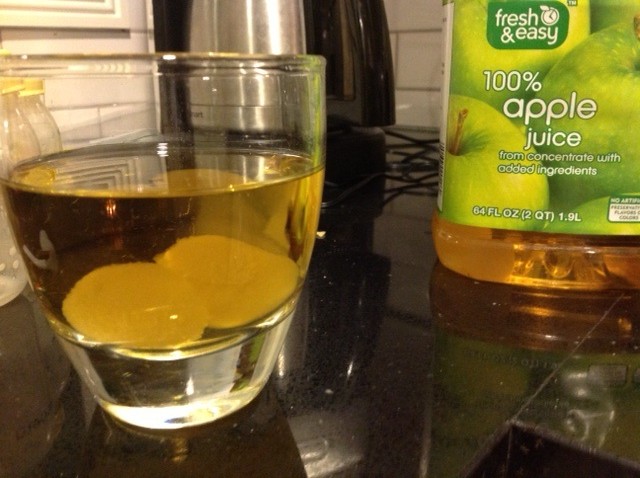 In which we ask our enlightened readers to solve a household mystery.
In which we ask our enlightened readers to solve a household mystery.
Scene: The Check-Hayden kitchen.
Erika (opens the refrigerator): Hm, this apple juice has been in here for a while. I should probably just finish it off.
(Opens bottle, pours juice into glass.)
Erika (disgusted): What the….!
(Tom walks in)
Erika (points to juice glass): What on earth are these blobs in my juice? I think I’m going to be sick! Have you ever seen anything like this?
Tom: Wow! No, I don’t think I have! Wait a second – let me take a look at that. (peers closer) I have! It was a long time ago, in a sewage treatment plant. But I think I’ve seen something like this before, and I think I know what it is!
Erika: I don’t want to know – can you just get rid of it?
End scene.
Here’s the part where you help us, dear reader: Can you help us solve our conundrum? What exactly has happened to our apple juice? Is Tom right – could you see something similar in a sewage plant?
And – most important – can we still drink the juice?
*****
Photo credit: Thomas Hayden.
Most “fresh” juices, just like this one according to the label, are made from concentrates, i.e. the fruit pulp is reduced to a concentrate in the country of origin, often pressed into a tight mass by vacuum treatment. It gets shipped to the place where it is made into juice, water is added to the concentrate and there you have it.
Based on this, my guess is that in your glass the apple juice has separated itself back into concentrate and watery juice.
That is the benign attempt of explanation.
Could be an emulsifier, check out the “added ingredients” mentioned on your label. However, not all emulsifiers must be declared, depends on where the juice was made (“adulterated”). Only organic growers/producers declare all ingredients, usually.
I would not drink it any longer but mainly for reasons of taste and looks.
They look like little “mothers” to me. Symbiotic colonies of yeast and fungi that convert the sugar into vinegar (like kombucha). I wouldn’t freak, but I wouldn’t drink it.
I have seen it before and I think scrytech, above, is right. I think where I’ve seen it is in apple cider after it’s been around a while and just before it gets really interesting to drink. Don’t take my word for any of this. I wouldn’t drink it either.
Yes, definitely a yeast contaminant. Here’s a chapter for a food micro book on drink contaminats: http://www.123foodscience.com/food_microbiology/Microbiology_of_soft_drinks_and_fruit_juices.pdf
Yep, definitely a yeast or fungal contaminant. These could have germinated from spores in the juice, or could have wafted in while the container was open. This is a really common sight in media in the lab (unfortunately). Oh, by the way, I wouldn’t drink it!
Wow. Just, wow. This is why I love you, LWON readers – for offering us not just one, but *two* eminently plausible explanations, complete with references. Y’all are amazing!
They look like mangos. lol
I agree with the posters above that are talking about yeast or fungal contaminates. It is possibly bacteria too, but the UFO shape leads me to think yeast or bacteria.
Contrary to common thought beverages are not sterile, not even water in a jar. The low temperature keeps bacteria from growing and of course they are treated (usually heat) to kill off most of what is there. Since yeast and mold are more likely to grow at refrigeration temperature that is another vote for yeast or mold.
If you really want to know what it is you can send it off for testing to a local laboratory like Silliker or try on the cheap by going to your local university and seeing if someone will test it for you. A simple stain and looking under the microscope will tell you the gross “what” even if not the fine version with the genus and species.
Net: probably won’t kill you but I wouldn’t drink it. However, maybe you are lucky and it turned alcoholic.
Will there be an answer to the mystery? Even without a stain, round yeast cells and/or branched hyphae ought to be visible…it that’s what it is.
Back in olden days when I was a biology TA we grew yeast in apple juice and counted them using a microscope and a gadget called a hemocytometer. This is a calibrated chamber that holds a drop of liquid with suspended cells: red, white or yeast.
Using the lines carefully scored on the chamber its possible to count the cells. In fact in olden days, it was the ONLY way to count them.
Please, please send it off to a laboratory. It’s the food safety equivalent of sending a saliva sample off to a genetics lab. Better yet, get a friend who works at a lab involved, and streak your own agar plates!
Also, take some of it (in case it is mother or mere) and put it in a dark non-reactive container with more apple juice to make apple cider vinegar.